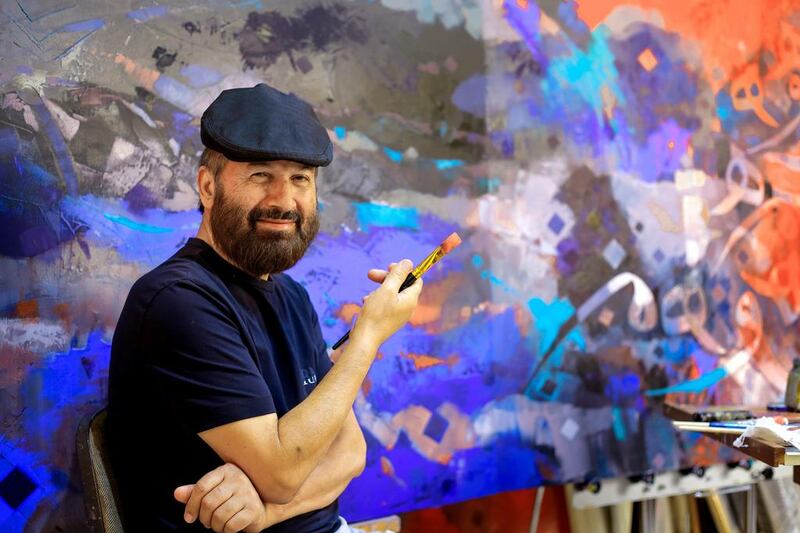Abdul Qader Al Rais greets all visitors to his studio with an obvious sense of warmth. Inside his workspace, which is part of his home in Dubai, paintings are piled high, with one always on the go.
Al Rais, who is in his 60s, is one of the pioneering talents of the UAE’s art scene and his works hang on the walls of an impressive number of palaces and government offices. He has even accrued a remarkable following, including Sheikh Mohammed bin Rashid, Vice President and the Ruler of Dubai, and Sheikha Salama bint Hamdan Al Nahyan, who are both collectors of his work. Yet, despite all his achievements, the artist takes compliments with humility.
“My talent is something I have no control over,” he says. “It is a gift from God.”
Al Rais began painting seriously in 1965, when he was 14 years old. His father died and his mother sent him to live in Kuwait with his sister and her hsband. “I was lucky because the Kuwaiti government was supporting art at that time so I had access to all the art materials I needed for free.”
Those materials included textbooks on Renaissance masters such as Raphael, Leonardo da Vinci and Rembrandt, all of whom Al Rais describes as his first art teachers. “I couldn’t read English, so I just looked at their pictures in art books and I was amazed by their talent. Later, I learnt from Monet, Degas and Pissarro because I also love impressionism and by 1968 I had developed my own style.”
It was that year that Al Rais painted The Wait, an oil-on-canvas depicting two boys sitting on the floor and a third standing behind them. This is the oldest painting selected by Sheikha Hoor Al Qasimi for the UAE's National Pavilion exhibition at this year's Venice Biennale. For the show titled 1980 – Today: Exhibitions in the United Arab Emirates, Al Qasimi chose 15 Emirati artists with work dating mostly from the 1980s. Al Rais is the only artist whose work spans from earlier, offering viewers a look back at the last few decades of art production in the UAE. Al Rais has three other works in the exhibition, including a self-portrait from 1973.
“Together, the artists chosen for the exhibition represent a specific period of time,” he says. “This is the history of art in the UAE and is really important. For me personally, it makes me feel very proud to know that I have contributed something to my country, especially as some of these works were painted even before unification.”
The paintings showing in Venice are also particularly precious because they represent a period in Al Rais’s oeuvre that no longer exists. When he returned to the UAE from Kuwait in 1974, he stopped painting for a period of 12 years – a hiatus that he attributes to a lack of inspiration and changes in his personal life. When he eventually picked up the brush again, he no longer painted figures. Instead, Al Rais concentrated on sweeping landscapes, architectural studies and abstract forms.
“Now, when I am painting, I try to bring out the beauty of what I see, whether it is in a landscape or a small detail like the door of a house.”
His paintings are now created mostly with watercolours and he has dedicated a large part of his time in recent years to passing on his knowledge to budding artists.
In Washington, DC, where his work was exhibited last year in an exhibition titled Past Forward: Contemporary Art from the Emirates, Al Rais taught schoolchildren watercolour techniques and some history about the UAE.
His work also graces the side of one of the many Metro trains traversing Dubai. Al Rais was one of five artists commissioned to produce art featured on a train as part of the efforts of Sheikh Mohammed, to encourage public art in Dubai.
“Of course all this makes me proud,” says Al Rais. “But I also think there should be a museum in the UAE to document all of our work for future generations. God willing, this will happen soon.”
aseaman@thenational.ae





